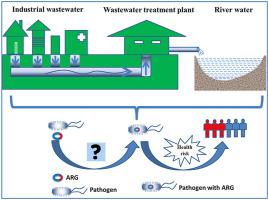Chemosphere ( IF 8.1 ) Pub Date : 2021-06-16 , DOI: 10.1016/j.chemosphere.2021.131224 Yao Tang 1 , Zhishu Liang 2 , Guiying Li 2 , Huijun Zhao 3 , Taicheng An 2

|
The aquatic environment may represent an essential route for transmission of antibiotic resistance to opportunistic human pathogens. Since industrial wastewater is discharged into the river after treatment, understanding the distribution of antibiotic resistance genes (ARGs) in river systems and the possibility of pathogens acquiring antibiotic resistance are challenges with far-reaching significance. This work mainly studied distribution profiles of pathogens and ARGs, and compared their health risk in various industrial wastewater with that of river water. Results showed that 166 pathogens were concurrently shared by the six water samples, with Salmonella enterica and Pseudomonas aeruginosa being the most abundant, followed by Fusarium graminearum and Magnaporthe oryzae. The similar composition of the pathogens suggests that pathogens in river water may mainly come from sewage discharge of slaughterhouses and that changes in water quality contribute significantly to the prevalence of these pathogens. Of the 57 ARG types detected, bacitracin was the most abundant, followed by sulfonamide, chloramphenicol, tetracycline, and aminoglycoside. Strikingly, the wastewater from a pharmaceutical factory producing Chinese medicine was also rich in bacA, sul1, mexW, mexB, mexF and oprn. It can be seen from the co-occurrence patterns that pathogens and the main ARGs have strong co-occurrence. Higher abundance of offensive virulence factors in industrial wastewater and their strong correlation with pathogens containing ARGs suggest higher microbiological risk. These findings highlight the need to assess ARG acquisition by pathogens in the surface water of human-impacted environments where pathogens and ARGs may co-thrive.
中文翻译:

各种工业废水和相关接收地表水中病原体和抗生素抗性基因的宏基因组特征和健康风险
水生环境可能是将抗生素抗性传播给机会性人类病原体的重要途径。由于工业废水经过处理后排入河流,了解河流系统中抗生素抗性基因(ARGs)的分布以及病原体获得抗生素抗性的可能性是具有深远意义的挑战。本工作主要研究了病原体和ARGs的分布特征,并比较了它们在各种工业废水中与河水中的健康风险。结果表明,6个水样同时共有166种病原体,其中肠道沙门氏菌和铜绿假单胞菌含量最高,其次是禾谷镰刀菌和稻瘟病菌。病原体的相似组成表明河水中的病原体可能主要来自屠宰场的污水排放,水质的变化对这些病原体的流行有显着影响。在检测到的 57 种 ARG 中,杆菌肽含量最高,其次是磺胺、氯霉素、四环素和氨基糖苷。引人注目的是,一家生产中药的制药厂的废水也富含bacA、sul1、mexW、mexB、mexF和oprn. 从共现模式可以看出,病原体与主要的 ARGs 具有很强的共现性。工业废水中较高丰度的攻击性毒力因子及其与含有 ARG 的病原体的强相关性表明较高的微生物风险。这些发现强调需要评估病原体和 ARG 可能共同繁殖的人类影响环境的地表水中病原体的 ARG 获取。











































 京公网安备 11010802027423号
京公网安备 11010802027423号